2002 MERCEDES-BENZ ML55AMG air condition
[x] Cancel search: air conditionPage 301 of 342
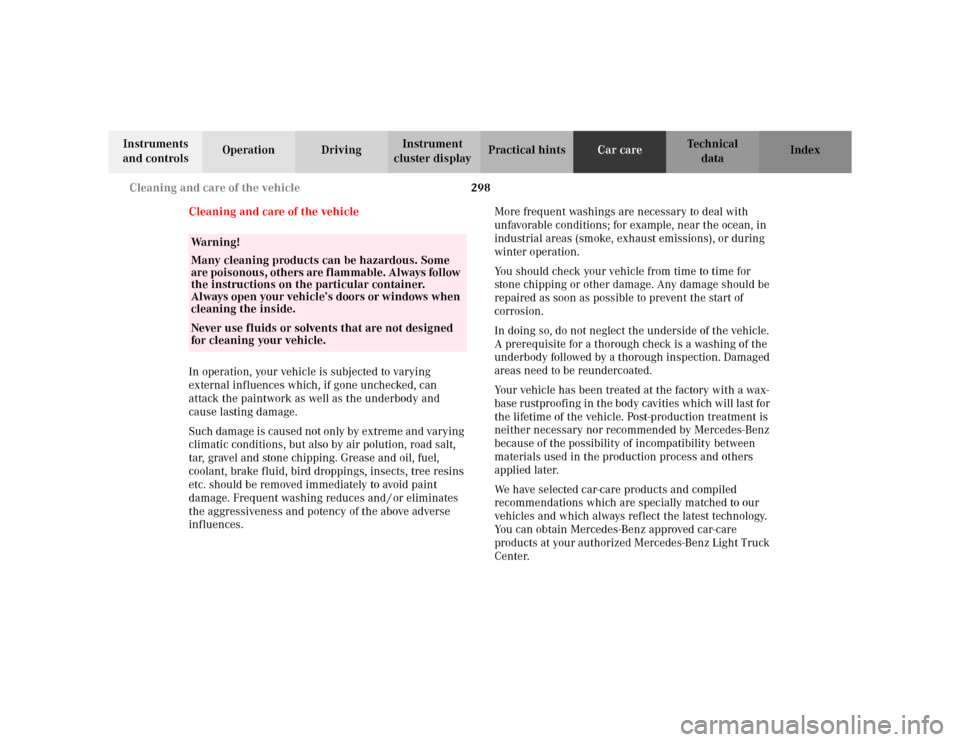
298 Cleaning and care of the vehicle
Te ch n i c a l
data Instruments
and controlsOperation DrivingInstrument
cluster displayPractical hintsCar careIndex
Cleaning and care of the vehicle
In operation, your vehicle is subjected to varying
external influences which, if gone unchecked, can
attack the paintwork as well as the underbody and
cause lasting damage.
Such damage is caused not only by extreme and varying
climatic conditions, but also by air polution, road salt,
tar, gravel and stone chipping. Grease and oil, fuel,
coolant, brake fluid, bird droppings, insects, tree resins
etc. should be removed immediately to avoid paint
damage. Frequent washing reduces and / or eliminates
the aggressiveness and potency of the above adverse
influences.More frequent washings are necessary to deal with
unfavorable conditions; for example, near the ocean, in
industrial areas (smoke, exhaust emissions), or during
winter operation.
You should check your vehicle from time to time for
stone chipping or other damage. Any damage should be
repaired as soon as possible to prevent the start of
corrosion.
In doing so, do not neglect the underside of the vehicle.
A prerequisite for a thorough check is a washing of the
underbody followed by a thorough inspection. Damaged
areas need to be reundercoated.
Your vehicle has been treated at the factory with a wax-
base rustproofing in the body cavities which will last for
the lifetime of the vehicle. Post-production treatment is
neither necessary nor recommended by Mercedes-Benz
because of the possibility of incompatibility between
materials used in the production process and others
applied later.
We have selected car-care products and compiled
recommendations which are specially matched to our
vehicles and which always reflect the latest technology.
You can obtain Mercedes-Benz approved car-care
products at your authorized Mercedes-Benz Light Truck
Center.
Wa r n i n g !
Many cleaning products can be hazardous. Some
are poisonous, others are flammable. Always follow
the instructions on the particular container.
Always open your vehicle’s doors or windows when
cleaning the inside.Never use fluids or solvents that are not designed
for cleaning your vehicle.
Page 308 of 342
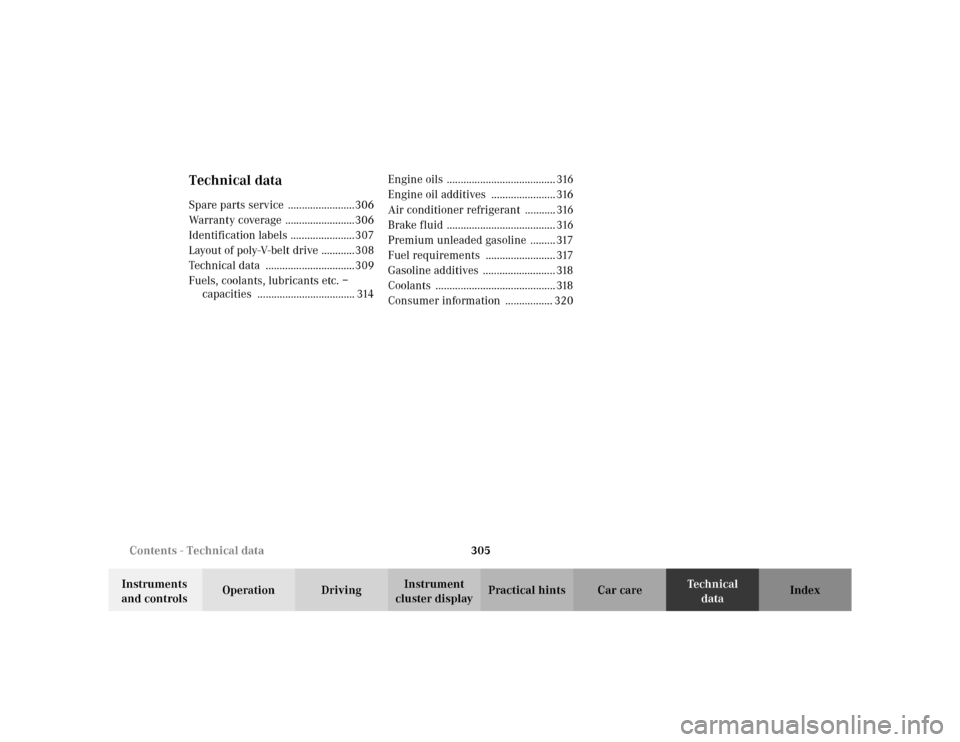
305 Contents - Technical data
Te ch n i c a l
data Instruments
and controlsOperation DrivingInstrument
cluster displayPractical hints Car care Index
Technical dataSpare parts service ........................306
Warranty coverage .........................306
Identification labels .......................307
Layout of poly-V-belt drive ............308
Technical data ................................309
Fuels, coolants, lubricants etc. –
capacities ................................... 314Engine oils ....................................... 316
Engine oil additives ....................... 316
Air conditioner refrigerant ........... 316
Brake fluid ....................................... 316
Premium unleaded gasoline ......... 317
Fuel requirements ......................... 317
Gasoline additives .......................... 318
Coolants ........................................... 318
Consumer information ................. 320
Page 311 of 342
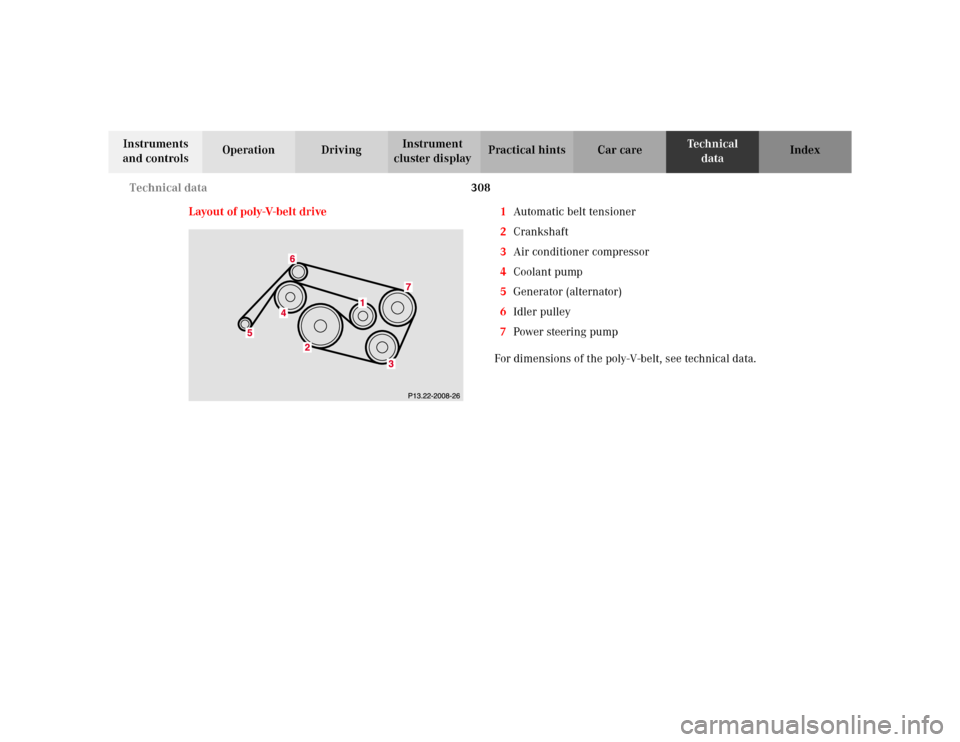
308 Technical data
Te ch n i c a l
data Instruments
and controlsOperation DrivingInstrument
cluster displayPractical hints Car care Index
Layout of poly-V-belt drive 1Automatic belt tensioner
2Crankshaft
3Air conditioner compressor
4Coolant pump
5Generator (alternator)
6Idler pulley
7Power steering pump
For dimensions of the poly-V-belt, see technical data.
Page 318 of 342
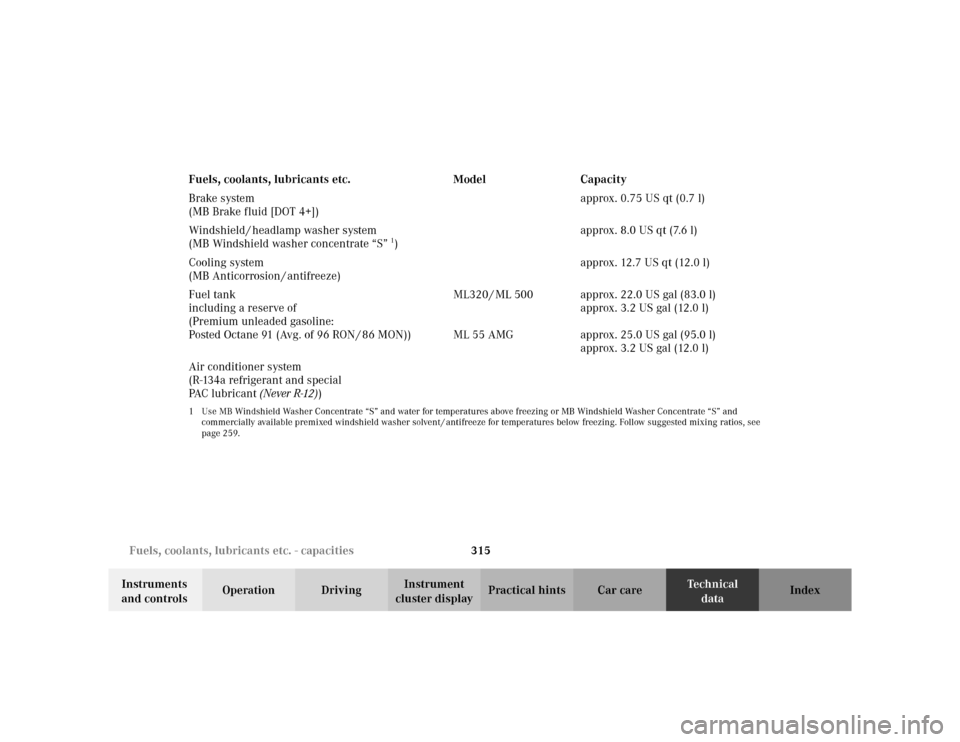
315 Fuels, coolants, lubricants etc. - capacities
Te ch n i c a l
data Instruments
and controlsOperation DrivingInstrument
cluster displayPractical hints Car care Index Brake system
(MB Brake fluid [DOT 4+])approx. 0.75 US qt (0.7 l)
Windshield / headlamp washer system
(MB Windshield washer concentrate “S”
1)approx. 8.0 US qt (7.6 l)
Cooling system
(MB Anticorrosion / antifreeze)approx. 12.7 US qt (12.0 l)
Fuel tank
including a reserve of
(Premium unleaded gasoline:
Posted Octane 91 (Avg. of 96 RON / 86 MON))ML320 / ML 500
ML 55 AMGapprox. 22.0 US gal (83.0 l)
approx. 3.2 US gal (12.0 l)
approx. 25.0 US gal (95.0 l)
approx. 3.2 US gal (12.0 l)
Air conditioner system
(R-134a refrigerant and special
PA C l u b r i c a n t (Never R-12))
1 Use MB Windshield Washer Concentrate “S” and water for temperatures above freezing or MB Windshield Washer Concentrate “S” and
commercially available premixed windshield washer solvent / antifreeze for temperatures below freezing. Follow suggested mixing ratios, see
page 259.Fuels, coolants, lubricants etc. Model Capacity
Page 319 of 342
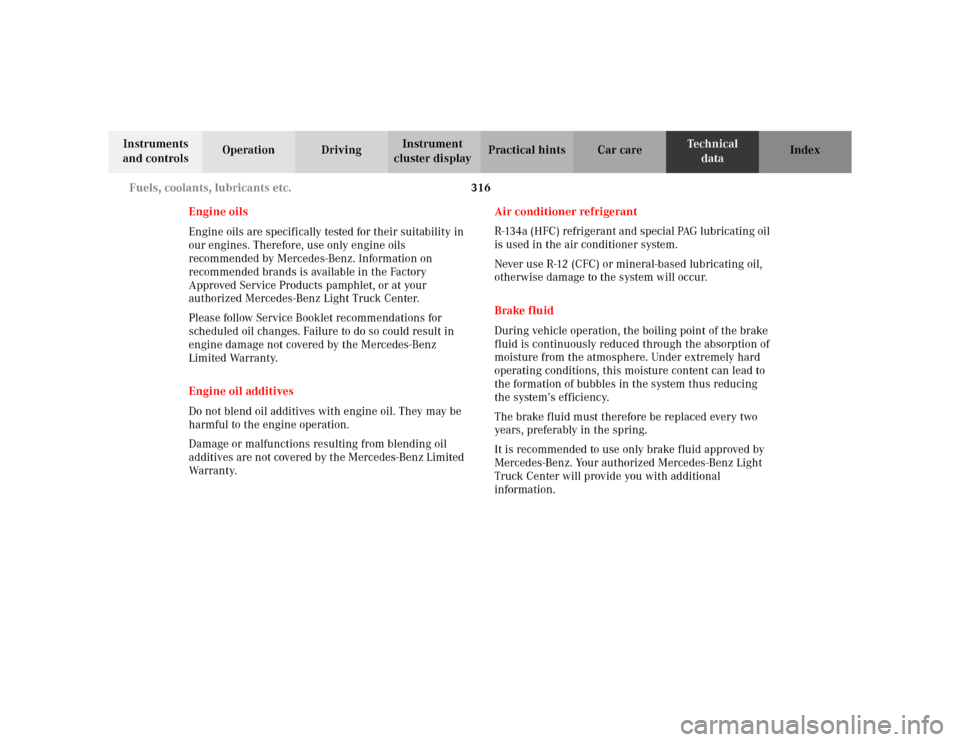
316 Fuels, coolants, lubricants etc.
Te ch n i c a l
data Instruments
and controlsOperation DrivingInstrument
cluster displayPractical hints Car care Index
Engine oils
Engine oils are specifically tested for their suitability in
our engines. Therefore, use only engine oils
recommended by Mercedes-Benz. Information on
recommended brands is available in the Factory
Approved Service Products pamphlet, or at your
authorized Mercedes-Benz Light Truck Center.
Please follow Service Booklet recommendations for
scheduled oil changes. Failure to do so could result in
engine damage not covered by the Mercedes-Benz
Limited Warranty.
Engine oil additives
Do not blend oil additives with engine oil. They may be
harmful to the engine operation.
Damage or malfunctions resulting from blending oil
additives are not covered by the Mercedes-Benz Limited
Warranty.Air conditioner refrigerant
R-134a (HFC) refrigerant and special PAG lubricating oil
is used in the air conditioner system.
Never use R-12 (CFC) or mineral-based lubricating oil,
otherwise damage to the system will occur.
Brake fluid
During vehicle operation, the boiling point of the brake
fluid is continuously reduced through the absorption of
moisture from the atmosphere. Under extremely hard
operating conditions, this moisture content can lead to
the formation of bubbles in the system thus reducing
the system’s efficiency.
The brake fluid must therefore be replaced every two
years, preferably in the spring.
It is recommended to use only brake fluid approved by
Mercedes-Benz. Your authorized Mercedes-Benz Light
Truck Center will provide you with additional
information.
Page 325 of 342
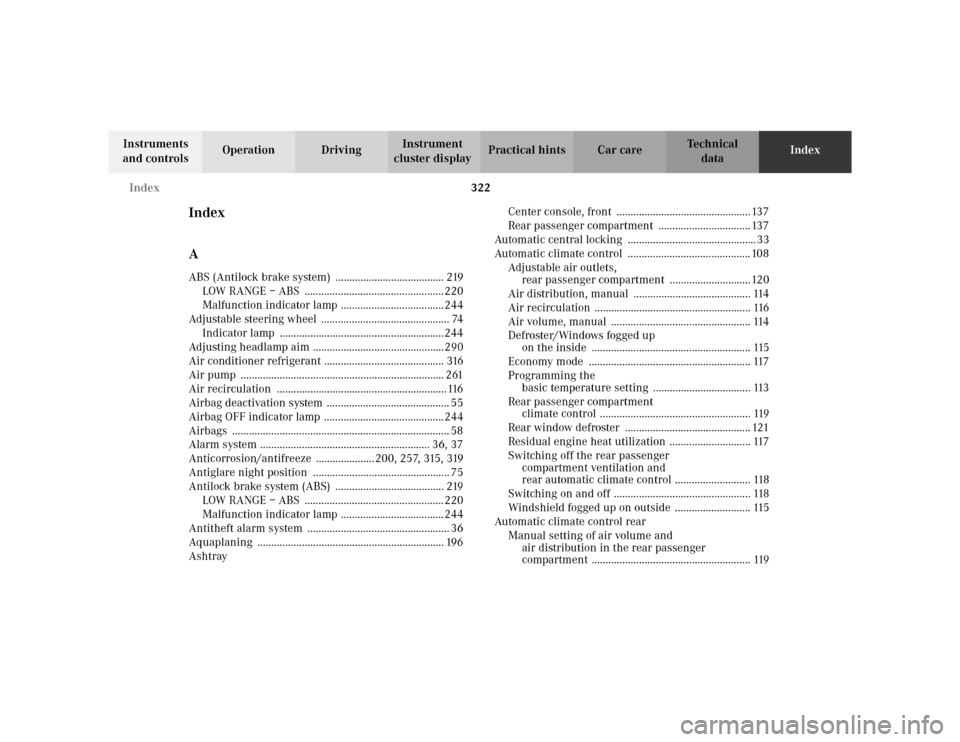
322 Index
Te ch n i c a l
data Instruments
and controlsOperation DrivingInstrument
cluster displayPractical hints Car careIndex
Index
AABS (Antilock brake system) ....................................... 219
LOW RANGE – ABS .................................................. 220
Malfunction indicator lamp ..................................... 244
Adjustable steering wheel .............................................. 74
Indicator lamp ...........................................................244
Adjusting headlamp aim ...............................................290
Air conditioner refrigerant ........................................... 316
Air pump ......................................................................... 261
Air recirculation .............................................................116
Airbag deactivation system ............................................ 55
Airbag OFF indicator lamp ........................................... 244
Airbags .............................................................................. 58
Alarm system ............................................................. 36, 37
Anticorrosion/antifreeze ..................... 200, 257, 315, 319
Antiglare night position ................................................. 75
Antilock brake system (ABS) ....................................... 219
LOW RANGE – ABS .................................................. 220
Malfunction indicator lamp ..................................... 244
Antitheft alarm system ................................................... 36
Aquaplaning ................................................................... 196
AshtrayCenter console, front ................................................ 137
Rear passenger compartment ................................. 137
Automatic central locking .............................................. 33
Automatic climate control ............................................ 108
Adjustable air outlets,
rear passenger compartment .............................120
Air distribution, manual .......................................... 114
Air recirculation ........................................................ 116
Air volume, manual .................................................. 114
Defroster/Windows fogged up
on the inside ......................................................... 115
Economy mode .......................................................... 117
Programming the
basic temperature setting ................................... 113
Rear passenger compartment
climate control ...................................................... 119
Rear window defroster ............................................. 121
Residual engine heat utilization ............................. 117
Switching off the rear passenger
compartment ventilation and
rear automatic climate control ........................... 118
Switching on and off ................................................. 118
Windshield fogged up on outside ........................... 115
Automatic climate control rear
Manual setting of air volume and
air distribution in the rear passenger
compartment ......................................................... 119